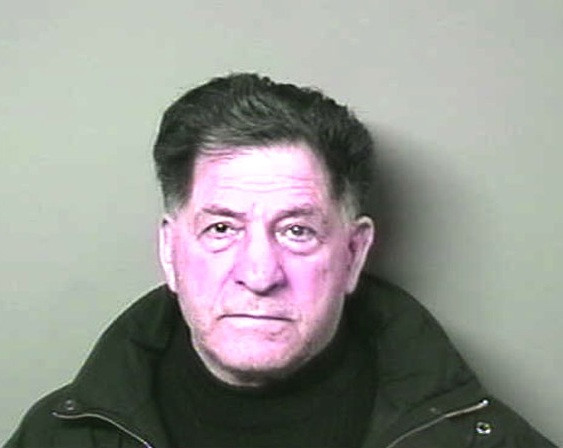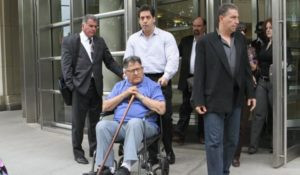 John Sonny Franzese Mugshot
John Sonny Franzese Mugshot
John “Sonny” Franzese, a notorious figure in the annals of American organized crime, lived a life that spanned a century, deeply entrenched in the violent world of the Mafia. His death at the age of 103 on Monday, February 24th, at a hospital, marked the end of an era, closing the chapter on one of the last links to the Mafia’s golden age. While the specific cause of death was not revealed, his passing served as a stark reminder of a bygone era of mob dominance in New York City and beyond.
Franzese was more than just a mobster; he was a living relic of a time when the Mafia wielded immense power and influence. Becoming a “made man” in the Colombo crime family at the age of 33, he thrived during the 1950s, the zenith of Mafia influence. His world was one of illicit wealth, rubbing shoulders with celebrities fascinated by the mob mystique like Frank Sinatra and Sammy Davis Jr., and celebrated Italian-American boxers such as Jake LaMotta and Rocky Graziano in Manhattan’s vibrant nightlife.
Throughout the 1950s, Franzese was deeply involved in the brutal realities of organized crime. Operating from Long Island, specifically Roslyn, he served under Joseph Magliocco, a powerful gang leader who took over the Profaci family (later known as the Colombo family) after Joe Profaci’s death in 1962. Franzese’s activities included forceful extortion, lucrative loansharking, bookmaking operations, and a chilling number of gangland murders, which he himself estimated to be between 40 and 50.
By the mid-1960s, Franzese’s criminal enterprises, particularly his harsh loansharking and bookmaking rackets, had expanded into the New York suburbs of Suffolk County. His ruthless methods were exemplified when he drove out the owners of an ice cream parlor to establish an illegal gambling den. However, this expansion occurred as law enforcement across the nation began to intensify their efforts against organized crime. Federal and New York authorities started to close in on Franzese’s operations.
His criminal empire began to unravel in late 1964 when the New York State Investigation Commission compelled Franzese and his associates to testify regarding criminal intimidation and extortion in Suffolk County. Franzese invoked his Fifth Amendment right against self-incrimination 18 times to avoid answering questions about his work for Magliocco. This defiance brought unwanted public attention, with Sonny and his photograph prominently featured in the New York Daily News, marking him as a person of interest in the fight against organized crime.
The ‘Muscle Man’ Enforcer and Rising Legal Pressure
Franzese’s notoriety as a “muscle man” enforcer and the head of rackets in Long Island grew. He became a primary target for law enforcement. In March 1966, a grand jury indicted him on charges connected to his role in strong-arming for a massive $10 million-per-year bookmaking operation that spanned New York’s Broadway and garment districts.
The legal pressure on Sonny Franzese escalated in April 1966 when the FBI arrested him following a federal grand jury indictment. He was named as the mastermind behind a gang responsible for robbing over $65,000 from four banks and loan associations across New York, Massachusetts, and Utah. Prosecutors believed this case marked the first instance of bank robbery orchestrated by the Cosa Nostra, highlighting the brazenness and reach of Franzese’s criminal network. Investigators also linked Franzese’s crew to the audacious theft of $2 million in jewelry from a Miami hotel in March 1966, further solidifying his reputation as a major player in national organized crime.
These mounting legal troubles extended into problems within the Mafia itself. In September of the same year, a clandestine meeting dubbed “Little Apalachin” by the press took place. Thirteen Cosa Nostra bosses, including prominent figures like Carlo Gambino, head of the Gambino family, and Santo Trafficante, the crime boss of Tampa, Florida, convened in the basement of a Queens restaurant. The purpose of this meeting was to discuss the increasingly problematic John Sonny Franzese, whose high profile was attracting too much unwanted attention.
Police learned of this secret meeting during a county grand jury investigation into Franzese and others suspected in the 1964 murder of Ernest “The Hawk” Rupolo, a Genovese gangster found dead in Jamaica Bay, stabbed and shot, his body weighed down with cinder blocks. Prosecutors, recognizing the significance of the attendees, detained all thirteen bosses as material witnesses in the Rupolo murder case, setting a high bail of $100,000 each. Despite their silence before the jury, Franzese and four other mobsters were indicted for Rupolo’s murder, indicating the deep trouble Franzese was now in with both the law and his own organization.
When Franzese appeared in a Queens criminal court for his arraignment on murder charges, New York Daily News reporters described the then 47-year-old as “a dapperly dressed, powerfully built man, wearing a gray, pinstriped suit and carrying a gray top coat,” painting a picture of a man who maintained a composed and stylish demeanor even in the face of serious accusations.
Colombo Family Captain and Downfall
Despite the serious charges, there was a mix of outcomes for Sonny Franzese. He managed to avoid conviction for the murder charge, and the bookmaking and loansharking charges also did not result in convictions. However, federal prosecutors prioritized the bank robbery case. In 1967, he was convicted and sentenced to a harsh 50-year term in federal prison, a significant victory for law enforcement in their fight against organized crime.
 Sonny Franzese at 100
Sonny Franzese at 100
J. Edgar Hoover, the long-serving FBI director, publicly listed Franzese’s lengthy prison sentence as one of the bureau’s major achievements in 1967. This recognition placed Franzese alongside other notorious criminals like Charles Battaglia and Sam Battaglia, highlighting the FBI’s successful crackdown on racketeering. That year saw a record number of racketeering convictions and charges, signaling a significant blow to mob operations across the country.
Franzese was granted parole in 1978, but his freedom was short-lived. He repeatedly violated parole, often by being caught meeting with known mob figures in public, resulting in multiple returns to prison – at least six times. Remarkably, even as he aged, his status within the New York underworld remained formidable. In 2005, the Colombo family, recognizing his experience and respect, appointed the elderly Franzese to the position of underboss, making him second-in-command at an advanced age.
Even at 93 years old, John Sonny Franzese continued his criminal activities, demonstrating an astonishing level of endurance in the underworld. He was still capable of using physical threats to extort payments from Manhattan strip clubs like Hustler and Penthouse, as well as a pizza restaurant in Long Island, proving his lasting influence and fear he instilled.
Family Betrayal and Final Years
Ultimately, it was his own family that played a crucial role in his final downfall. His son, John Jr., a former crack addict, decided to cooperate with the FBI, driven by his disillusionment with his father’s mob life. John Jr. wore a wire, recording hundreds of hours of conversations with his father, providing incriminating evidence in a racketeering case. His testimony in a Brooklyn federal court was pivotal in the case against his father. The tapes captured Sonny Franzese openly discussing his extortion schemes targeting the strip clubs, leaving little room for doubt about his continued criminal involvement.
Sonny’s second wife, Christina, though estranged, publicly supported her son John Jr.’s actions. She told the Daily News that he was “not testifying against his father, he’s testifying against this [Mob] life,” indicating a family deeply fractured by the consequences of organized crime.
However, another son, Michael Franzese, who himself had been involved in the Colombo family’s rackets before leaving the criminal life to become a motivational speaker and author, had a different perspective. While stating his continued love for his brother John Jr., Michael expressed his disapproval of his brother’s actions and his sympathy for his father, saying he felt “worse for my father” and knew “he’s very hurt by it.” Michael even produced a musical in 2018, A Mob Story, offering a dramatized, perhaps romanticized, view of mob life.
John Jr.’s cooperation was instrumental in securing Sonny Franzese’s conviction and an eight-year prison sentence for extortion in 2010. This became his final prison term. He was released in 2017 at the age of 100, becoming the oldest inmate in federal custody at the time. John “Sonny” Franzese’s life, marked by violence, crime, and an extraordinary longevity in the Mafia, ended a few years later, leaving behind a complex and controversial legacy in the history of American organized crime.
For feedback or questions, contact [email protected]
